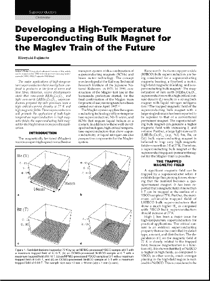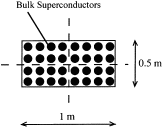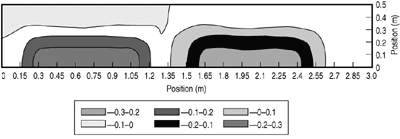 |
50 (10) (1998), pp. 16-18. |
|---|
 |
50 (10) (1998), pp. 16-18. |
|---|
 |
| CONTENTS |
|---|
The major applications of high-temperature superconductors have mostly been confined to products in the form of wires and thin films. However, recent developments show that rare-earth REBa2Cu3O7-x and light rare-earth LREBa2Cu3O7-x superconductors prepared by melt processes have a high critical-current density at 77 K and high magnetic fields. These superconductors will promote the application of bulk high-temperature superconductors in high magnetic fields; the superconducting bulk magnet for the Maglev train is one possible application.
The Maglev system applies the superconducting technology of low-temperature superconductors, Nb-Ti wires, and SCMs that require liquid helium as a coolant. In addition to these well-developed technologies, high-critical temperature superconductors that show superconductivity at liquid nitrogen are also prospective components for the Maglev system.
Rare-earth barium-copper-oxide (REBCO) bulk superconductors are being considered for a superconducting magnetic bearing, a flywheel, a motor, high-field magnetic shielding, and a superconducting bulk magnet.3 The magnetization of rare earth (RE)Ba2Cu3O7-x superconductors with a high critical-current density (Jc) results in a strong bulk magnet with liquid nitrogen refrigeration.4 The trapped magnetic field of the superconducting bulk magnet with a large single domain has been reported to be superior to that of a conventional permanent magnet. The superconducting bulk magnet can generate a higher magnetic field with increasing Jc and volume. Further, a large light rare earth (LRE)Ba2Cu3O7-x (e.g., Nd, Sm, Eu, or Gd) bulk superconducting magnet is believed to trap very high magnetic fields—more than 5 T at 77 K. Therefore, a superconducting bulk magnet or the superconducting quasi-permanent magnet for the Maglev train is possible.
Figure 1 shows the field distributions trapped by an MPMG-processed YBCO and an OCMG-processed SmBCO sample in liquid nitrogen at 3 T and 0 T.7 A difference in the trapped fields between two samples can be seen (i.e., in the external field of 3 T)—while YBCO can trap only a negligible field, SmBCO can trap a significant amount of magnetic flux. The reason is ascribed to a higher Jc in high fields for SmBCO. This result indicates that OCMG-processed LREBCO bulks can trap a much higher field than YBCO at 77 K when the sample dimension is similar. It is estimated that fields greater than 5 T can be trapped at 77 K if optimally processed large bulks are produced from these materials, because LREBCO bulk superconductors show a much higher Hirr.
| MELT-PROCESSED BULK SUPERCONDUCTORS |
|---|
| Many high-temperature superconductors show superconductivity at temperatures higher than liquid nitrogen (77 K). In sintered yttrium-barium-copper-oxide (YBCO), the Jc is low because of the existence of weak links, such as grain boundaries and defect structures. However, recent development shows that melt-processed REBCO superconductors (melt-textured growth, quench-and-melt growth, and melt-powder-melt-growth [MPMG] processes3) and LREBCO superconductors (oxygen-controlled melt growth [OCMG] process5,6) have a high Jc at 77 K and high magnetic fields. Solidification processes for producing REBCO and LREBCO superconductors are effective for obtaining a high Jc.
While reported Jc values of melt-processed YBCO superconductors have already surpassed the lower limit for practical applications, Jc enhancement above 105 A/cm2 and less severe degradation in high fields at 77 K are still required for better performance and an improved safety margin. An OCMG process for the LREBa2Cu3O7-x systems (Nd, Sm, or Eu) was developed to solve the fundamental problem of a depressed critical temperature with a broad superconducting transition of the materials when they were melt-processed in air.5 In comparison with optimally melt-processed YBCO superconductors, OCMG-processed LREBCO superconductors exhibit a larger Jc in high magnetic fields and a much improved irreversibility field (Hirr) at 77 K, implying that stronger flux pinning can be realized in a commercially feasible way. The highest onset-critical temperature with sharp transition was achieved at 96 K. For a practical process, melt processing in air has been favored, and the fabrication of fairly good quality NdBCO bulks with the melt process in air is also currently in progress. For practical applications, improvement in the mechanical properties is also essential. The strength and the fracture toughness of YBCO are improved by adding silver during the melt growth of the crystal from the partial molten state. Although some superconducting compounds from the Bi-Sr-Ca-Cu-O and Tl-Ba-Ca-Cu-O systems exhibit higher critical temperatures in comparison with the (L)RE-Ba-Cu-O system, they are considered inadequate for bulk-type applications at 77 K because their irreversibility lines are drastically depressed over a wide temperature range. The melt process opened the possibility of various monolithic bulk applications that are operative with liquid nitrogen refrigeration. |
It was found during testing that the SCM suffers from external magnetic disturbances caused by ground coils and mechanical vibrations generated by vehicle dynamics. These disturbances would cause the sudden disappearance of magnetomotive force of the SCM.
The vehicle in the Maglev system is levitated, guided, and propelled by electromagnetic forces acting between the superconducting magnets on board the vehicle and the ground coils, such as the levitation/guidance coils and the propulsion coils on the guideway, which correspond to the rail tracks of conventional railways.
For magnetic levitation, eight-figured levitation coils are installed on the sidewalls of the guideway. An electric current is induced in the coils when the on-board SCMs pass at a high speed, thereby levitating the Maglev vehicle. For lateral guidance, the levitation coils facing each other are connected under the guideway, constituting a loop. When an SCM on the Maglev vehicle displaces laterally, an electric current is induced in the loop, resulting in a repulsive force acting on the levitation coils near the car and an attractive force apart from the car. Thus, a running car is always located at the center of the guideway. For propulsion, a repulsive force and an attractive force induced between the magnets are used to propel the vehicle. The propulsion coils located on the sidewalls on both sides of the guideway are energized by a three-phase alternating current from a substation, creating a shifting magnetic field on the guideway. The on-board SCMs are attracted and pushed by the shifting field, propelling the Maglev vehicle.1,2
 |
Figure 2. A superconducting bulk magnet at  100 mm and 8 x 4 bulks. 100 mm and 8 x 4 bulks. |
Figure 2 shows a bulk magnet consisting of 8 x 4 bulks for a pole when the diameter of a bulk is 100 mm and the thickness is 20 mm. The distribution and magnitude of a perpendicular component of magnetic fields through the ground coils on the guideway were calculated by the Biot-Savart law. The gap between the surface of the bulk and the center of the ground coil is approximately 150 mm for the levitation/guidance coil. Magnetic fields for the conventional SCM composed of race-track coils are also calculated for comparison.8
Figure 3 shows the distribution of calculated magnetic fields at the center of the levitation/guidance coil for the case of 8 x 4 bulks when the current density of the bulk is 1 A/mm2. The distribution of the magnetic field of the bulk magnet is almost the same as that of the conventional race-track magnet. As a result, the current density necessary for the SCM of the Maglev train is estimated to be larger than 105 A/cm2 for a diameter of 100-200 mm and thickness of 20 mm. The generating magnetic field depends on the size, such as the diameter and the thickness, and the Jc of the bulk; currents flowing through the outer region of the bulk contribute much more to generating magnetic fields than those through the inner region. The required current density decreases with increasing thickness and size. It should be noted that mechanical properties limit the trapped magnetic field (i.e., Jc) due to the electromagnetic force.8
 |
| Figure 3. The distribution of calculated magnetic fields at the levitation/guidance coils. Each pole is composed of 8 x 4 bulks, 100 mm in diameter and 20 mm in thickness. |
ABOUT THE AUTHOR
Hiroyuki Fujimoto earned his Ph.D. in electrical engineering at Kyushu University, Japan, in 1994. He is currently a manager of the Materials Engineering Laboratory at the Railway Technical Research Institute.
For more information, contact H. Fujimoto, Railway Technical Research Institute, Materials Engineering Laboratory, 2-8-38 Hikari-cho, Ko-kubunji-shi Tokyo 185-8540, Japan; telephone 81-42-573-7297; fax 81-42-573-7360; e-mail fujimoto@rtri.or.jp.
Direct questions about this or any other JOM page to jom@tms.org.
| Search | TMS Document Center | Subscriptions | Other Hypertext Articles | JOM | TMS OnLine |
|---|